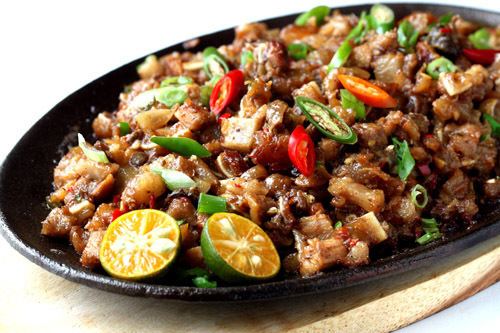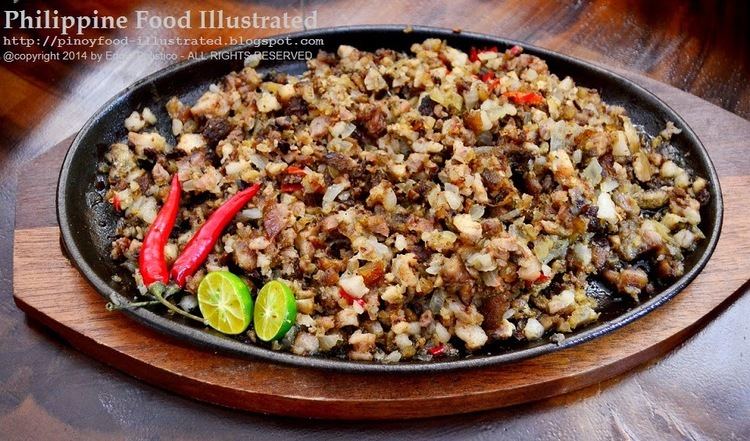Alternative names Sisig Place of origin Philippines | Serving temperature Hot | |
Main ingredients Pork jowls, ears and liver Similar Kare‑kare, Sinigang, Pancit, Philippine adobo, Crispy pata | ||
Sisig is a Filipino dish made from parts of pig’s head and liver, usually seasoned with calamansi and chili peppers.
Contents

Sisig was first mentioned in a Kapampangan dictionary in the 17th Century meaning "to snack on something sour". It usually refers to fruits, often unripe or half-ripe, sometimes dipped in salt and vinegar. It also refers to a method of preparing fish and meat, especially pork, which is marinated in a sour liquid such as lemon juice or vinegar, then seasoned with salt, pepper and other spices.

How to make sisig
Origin

The origins of the word dates back to 1732, and was recorded by Augustinian friar Diego Bergaño in his Vocabulary of the Kapampangan Language in Spanish and Dictionary of the Spanish Language in Kapampangan. Bergaño defines sisig as a "salad, including green papaya, or green guava eaten with a dressing of salt, pepper, garlic and vinegar." There is no mention of how long this cooking style has existed prior to the coming of the Spaniards during the Age of Conquest. The introduction of meat into the dish does not have an exact date as well.

Locals believe that the addition of a pig's head and innards in the dish came from "recycling" the excess meat from the commissaries of Clark Air Base in Angeles City, Pampanga. Pig heads were purchased cheap since they were not used in preparing meals for the U.S. Air Force personnel stationed there during the American Occupation of Luzon and Visayas.

Sisig still has many variations with recipes varying from city to city, and sometimes, family to family, in the Kapampangan province.
Sisig queen

Lucia Cunanan of Angeles City has been credited with reinventing sisig by using a sizzling plate to make the dish crispier. The Philippine Department of Tourism has acknowledged that her "Aling Lucing's" restaurant had established Angeles City as the "Sisig Capital of the Philippines" in 1974. Cunanan's trademark sisig was developed in mid-1974 when she served a concoction of boiled and chopped pig ears and cheeks seasoned with vinegar, calamansi juice, chopped onions and chicken liver and served in hot plates. Today, varieties include sisig ala pizzailo, pork combination, green mussels or tahong, mixed seafood, ostrich sisig, crocodile sisig, spicy python, frog sisig and tokwa't baboy, among others.
Preparation
According to Cunanan's recipe, preparing sisig comes in three phases: boiling, broiling and finally grilling. A pig's head is first boiled to remove hairs and to tenderize it. Portions of it are then chopped and grilled or broiled. Finally, coarsely chopped onions are added and served on a sizzling plate. Variations of sisig may add any of the following: eggs, ox brains, chicharon (pork cracklings), pork or chicken liver, and even mayonnaise. Recently, local chefs have experimented with ingredients other than pork such as chicken, squid, tuna, and tofu.
Annual Sisig Festival
The annual "Sisig Festival" (Sadsaran Qng Angeles) is held every year during the month of December in Angeles City, Pampanga, celebrating the Kapampangan dish. It started in 2003 and was made an annual festival by Mayor Carmelo Lazatin on December 2004 to promote the city's culinary prowess. The festival also features a contest where chefs compete in making dishes, primarily sisig. Congo Grille, a restaurant chain in the country, was a winner in 2006.
